 Author: Eiji OKUBO Sales Network: Amazon.com / Amazon.co.jp |
| Written by Eiji Okubo, Printed books and e-books Heritage of Minoan and Mycenaean civilizations Detailed data on Ruins and Excavated items |
| Legacy of the Mycenaean Civilization carefully selected Excavated 500 Items |
 |
| subtitle: Touring to Mycenaean civilization with precise illustrations of excavated artefacts language: English format: Paperback printing paper: Non-glossy high-quality paper printing ink: High-saturation premium ink size: 8in.x10in. (203mm x 254mm) 597 pages sales: Amazon Network / Amazon.com / Amazon.co.uk |
| Sumary: This book is 8in. x 10in. (203mm x 254mm) version, 590 pages, a “Precision Illustrations & Data Book” of excavated main items from the prehistoric Mycenaean Civilization ruins in mainland Greece. This book is picking up carefully selected “Excavated 500 Items” unearthed in important archaeological sites in the Argolis, Messenia, and Laconia regions, including the Mycenae Palace and surroundings ruins, which were the center of the Mycenaean Civilization. In this book, notable finds from the Mycenaean Civilization sites are compared with those from the Minoan Civilization of Crete to understand influences and connections. More than 90% of the excavated items explained are depicted in Precise Illustrations, and the rest are shown in Photographs. This book will invite you to the “World of Crafts and Arts” of the Mycenaean Civilization through carefully selected important works from among the excavated items on display at the National Archaeological Museum of Athens and other archaeological museums throughout the Peloponnese. Contents: I What is the Mycenaean Civilization? II Gold Products II-1 Gold Cup II-2 Gold Signet Ring II-3 Gold Death Mask, Breast-plate, Diadem II-4 Gold Necklace, Earrings, Hairpin II-5 Gold Accessories, Sheet processed products III Silver Products IV Semi-precious stones, Glass paste, Bronze Jewelry Products V Bronze Sword and Weapon VI Pottery VI-1 Pottery / EHII~LHI VI-2 Pottery / LHII VI-3 Pottery / LHIIIA VI-4 Pottery / LHIIIB VI-5 Pottery / LHIIIC VII Worship Statue VIII Fresco IX Stone Seal X Stone Products XI Pictograph/Hieroglyph, Linear A, Linear B XII Ivory Products XIII Bronze Daily Necessities |
| Sample Page:(excerpt) ---------- In the Mycenaean civilization, "Gold" was the most important symbol of the ruler. The “Gold Mask of Agamemnon,” for instance, excavated in 1876 during the excavation work of Grave Circle A, where inside of the citadel of the Mycenae Palace, by the German businessman J.H. Schliemann. He was called a “treasure-hunting archaeologist” by scholars and the public, Schliemann's excavations and his amazing track records, however, had a great impact on later scholars' studies of the Mycenaean civilization, and the excavated artifacts provided great evidence for the elucidation of the civilization. Eye-popping jewelry goods excavated from in the Mycenaean Palace and the surrounding ruins of the Mycenaean civilization, especially gold jewelry items have been found those who owned them to have lived in the palace, judging from the preciousness of the material, the style, and motifs expressed in the works. It can be concuded that they, owners of gold jewelry, were extremely noble people such as members of the royal family, their relatives, and of the nobility class. In addition, if it limits to the excavated items of high-quality jewelry, the number of unearthed articles is slightly less from the ruins of palace buildings or mansions, but most of them have come from the excavation of tombs inside and near the Mycenae Palace, where royal families and nobles were buried. II-1-01 Gold Goblet 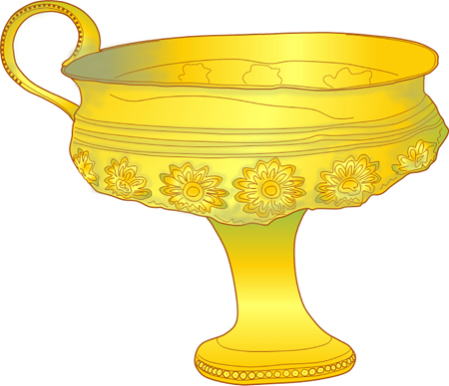 Site: Shaft Grave IV, GCA, Mycenae Palace Shape & Decoration: Gold Goblet with ring-handle rosettes in repoussé, handle and cup base in granulation technique Era: LHI, ca. 1550 BC Museum: NAM, inv. No. 351 Local: Argolis, Peloponnese Drawing: Eiji OKUBO II-1-02 Gold Shallow Cup 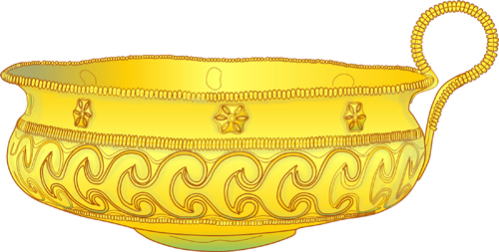 Site: Chamber Tomb 10, Dendra Shape & Decoration: Gold Shallow Cup, ivy & rosette patterns in repoussé mouth/rim and ring-handle in granulation technique Era: LHIIIA1, 1400-1375 BC Museum: NAM, inv. No. 8743 mouth diameter D130mm, H50mm excluding handle Local: Argolis, Peloponnese / 9km east-northeast from Argos city Drawing: Eiji OKUBO GPS: 37°39’2’’N 22°49’32’’E / ALT 60m II-1-03 Gold Stemmed Cup 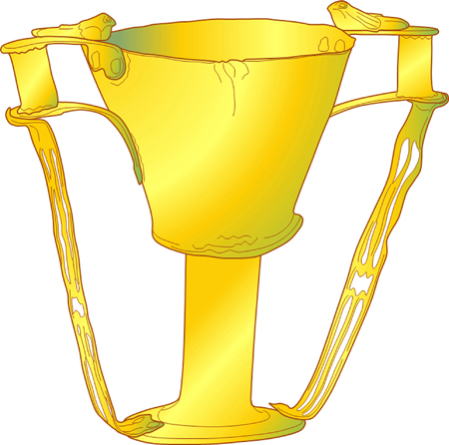 Site: Shaft Grave IV, GCA, Mycenae Palace Shape & Decoration: Gold Stemmed Cup in Vaphio style, doves on mouth/rim so-called the “Nestor’s Cup” and “Dove Cup” Era: LHI, ca. 1550 BC Museum: NAM, inv. No. 412 / handle outer width max. 145mm Local: Argolis, Peloponnese Drawing: Eiji OKUBO II-1-04 Gold Carinated Cup 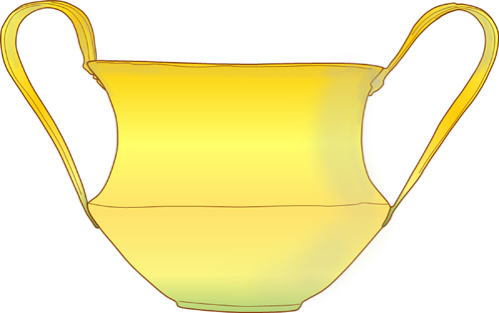 Site: Shaft Grave IV, GCA, Mycenae Palace Shape & Decoration: Gold Carinated Cup undecorated with handles in Kantharos type Era: LHI, ca. 1550 BC Museum: NAM inv. No. 440 / mouth/rim diameter D112mm height H92mm excluding handle, weight 205g Local: Argolis, Peloponnese Drawing: Eiji OKUBO Related: Grave Circle A/GCA, Mycenae Palace In 1876, German businessman J.H. Schliemann discovered a double stone slab circle with a maximum outer diameter of 27.5 m inside the citadel of the Mycenae Palace ruins in the Peloponnese-Argolis region, currently a UNESCO World Heritage Site. The circular ruins were a large cemetery called "Grave Circle A," which dates back to the 16th century BC. Grave Circle A in the Mycenae Palace is located immediately to the right of the interior after entering through the Lion Gate, the main gate of the palace area. In Grave Circle A, the Shaft Grave I to Grave V were discovered during Schliemann's excavation work, and later the Shaft Grave VI was discovered by Greek researcher Panagiotis Stamatakis. Schliemann called initially this area of Grave Circle A the "Agora" which later meant a public square and market place in Ancient Greece. 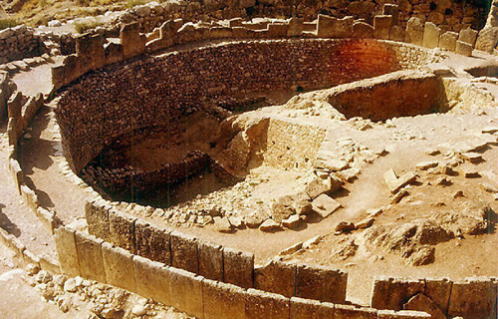 Site: Grave Circle A, Mycenae Palace Situation: A unique Mycenaean cemetery a) double slab circle=outer diameter 27.5m, inner 25m b) center left tomb=largest Shaft Grave IV c) center right tomb=Shaft Grave I Era: MHIII-LHI, 1625-1500 BC Local: Argolis, Peloponnese / 11km north-northeast from Argos city Photo: 1982 GPS: 37°43'49.50''N 22°45'23''E / ALT 240m 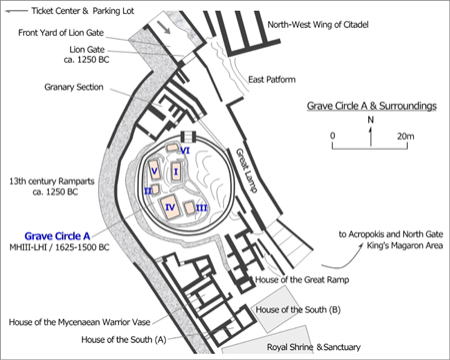 Site: Plan of Grave Circle A & surroundings, Mycenae Palace Local: Argolis, Peloponnese Drawing: Eiji OKUBO Grave Circle A had a structure in which double circle-shaped stone slabs surrounded the ground surface. The stone slab circle is not a perfect circle, but a slightly distorted, almost circular shape, with the maximum outer diameter of the outer circle being approximately 27.5m, and the inner diameter of the inner circle being about 25m. A total of 19 bodies had been buried in Grave Circle A, including eight adult men, nine women, and two children. The burial persons are undoubtedly members of the second or third generation of the royal family who lived in the Mycenae Palace approximately 3,600 to 3,500 years ago, or members of the royal family or relatives, such as the king's brothers. Burial bodies in GCA: Shaft Grave I: 3 women Shaft Grave II: 1 man Shaft Grave III: 3 women and 2 children Shaft Grave IV: 3 men and 2 women Shaft Grave V: 3 men Shaft Grave VI: 1 man and 1 woman II-2-09 Gold Seal 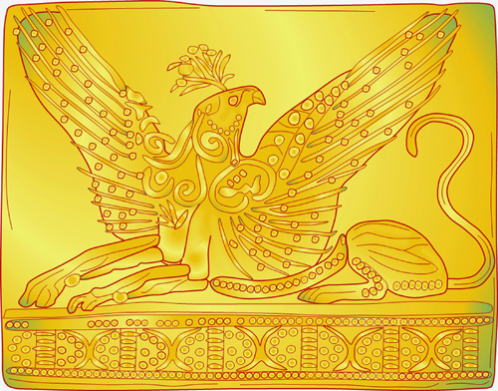 Site: Royal Tholos Tomb IV, Nestor’s Palace Shape & Decoration: Gold Seal, cushion shape intaglio, a griffin spreading wings, triglyph pattern back side=diamond (mesh) pattern Era: MHIII-LHIIA, 1650-1450 BC Museum: NAM, inv. No. 7986 / L27mm, W21mm, T6mm Local: Messenia, Peloponnese<br> 13km north from Pylos port, 35km west from Kalamata city Drawing: Eiji OKUBO Royal Tholos Tomb IV, Nestor’s Palace 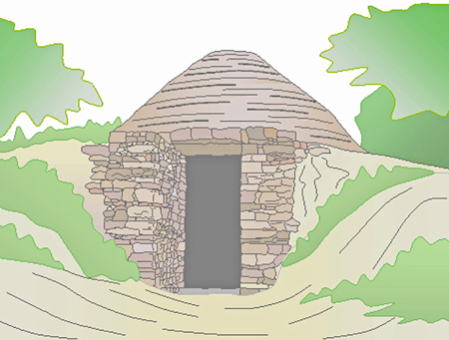 Site: Royal Tholos Tomb IV, Nestor’s Palace (as of 1982) Situation: from Dromos to Entrance a) Tholos chamber: Semi-underground type, inner diameter 9.35m b) ceiling: concrete restoration Era: MHIII-LHIIIA a) 1650-1450 BC=continuous burial for 200 years b) 1450-1350 BC=intermittent burial for 100 years Local: Messenia, Peloponnese / 13km north from Pylos port Drawing: Eiji OKUBO GPS: 37°01'38''N 21°41'42''E / ALT 195m A total of 19 people of the highest rank of the Mycenae Palace, including kings, queens, and members of the royal family, had been buried in the Grave Circle A. During Schliemann’s excavations, from the GCA, multiple gold death masks that covered the face of male burials and beautiful form gold cups were excavated, as well as gold crowns, and dazzling jewelry such as earrings and necklaces that would have been worn by female royals. In addition, an endless number of finely decorated daggers inlaid with gold and special metals, various silverware and bronze vessels, and many ceramics with a characteristic pattern of the early Mycenaean civilization have been unearthed from Shaft Graves of the GCA. II-2-13 Gold Signet Ring, “Treasure of Aidonia” 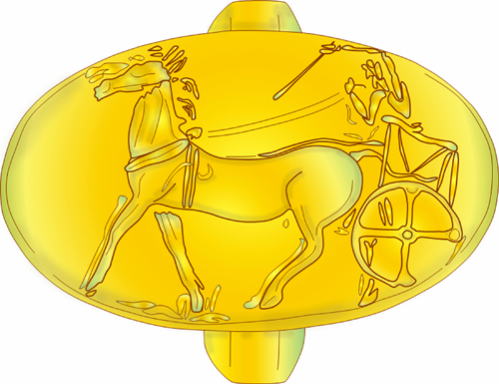 Site: Chamber Tomb 7, Aidonia, near Nemea Shape & Decoration: Gold Signet Ring, “Treasure of Aidonia” two-wheeled chariot and a man Era: LHI-LHII, ca.1500 BC Museum: NEAM, inv. No. 1005 / L33.5mm Local: Corinthia, Peloponnese / 20 km northwest of Mycenae Palace Drawing: Eiji OKUBO II-3-01 Gold Death-mask  Site: Shaft Grave V, GCA, Mycenae Palace Shape & Decoration: Gold Death-mask, in repoussé Excavator J.H. Schliemann's conjecture: “Gold Mask of Agamemnon,” 13th century BC scholar's judgment: Death-mask of a "King" over 300 years older than "King Agamemnon" Era: LHI, ca. 1550 BC Museum: NAM, inv. No. 624 / H250mm, weight 168.5g Local: Argolis, Peloponnese Photo: 1987 II-3-03 Electrum alloy Death-mask  Site: Shaft Grave Γ, GCB, Mycenae Shape & Decoration: Electrum alloy Death-mask, made by gold & silver alloy, in repoussé a burial good of the pioneering of "mask-covered burial" in the Early Mycenaean period Era: MHIII, 1625-1550 BC Museum: NAM, inv. No. 8709 / H240mm Local: Argolis, Peloponnese Drawing: Eiji OKUBO II-4-07 Gold Earrings  Site: Shaft Grave III, GCA, Mycenae Palace Shape & Decoration: Gold Earrings, chained plant petals, fine granulation technique Era: LHI, 1550-1500 BC Museum: NAM, inv. No. 61 / outer width L76mm Local: Argolis, Peloponnese Drawing: Eiji OKUBO III-11 Silver funnel-shaped Rhyton, so-called ”Siege Battle" 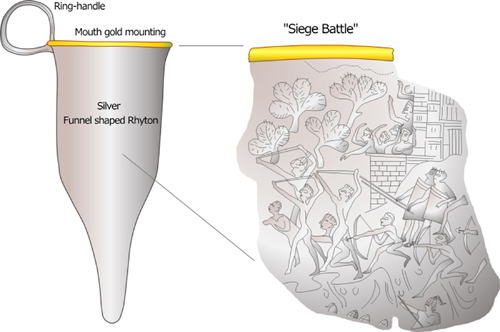 Site: Shaft Grave IV, GCA, Mycenae Palace Shape & Decoration: Silver funnel-shaped Rhyton, ring-handle, mouth gold mounting so-called ”Siege Battle" Era: LHI, ca. 1550 BC Museum: NAM, inv. No. 481 / body diameter D114mm Local: Argolis, Peloponnese Drawing: Eiji OKUBO IV-05 Carnelian bead Necklace 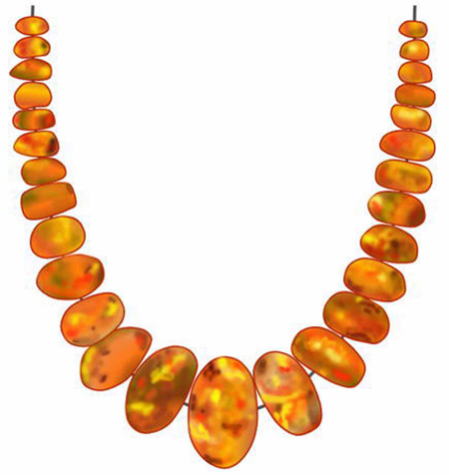 Site: Shaft Grave III, GCA, Mycenae Palace Shape & Decoration: Amber bead Necklace Era: LHI, 1550-1500 BC Museum: NAM Local: Argolis, Peloponnese Drawing: Eiji OKUBO V-04 Bronze Dagger, “Tangles type”  Site: Shaft Grave V, GCA, Mycenae Shape & Decoration: Bronze Dagger of the “Tangles type,” with gold hilt a) grip-handle=lily flowers on hilt in repoussé b) niello and electrum alloy inlay technique on blade Era: LHI, ca. 1550 BC Museum: NAM, inv. No. 764 / L180mm Local: Argolis, Peloponnese Drawing: Eiji OKUBO V-05 Bronze Dagger, “Tangles type” 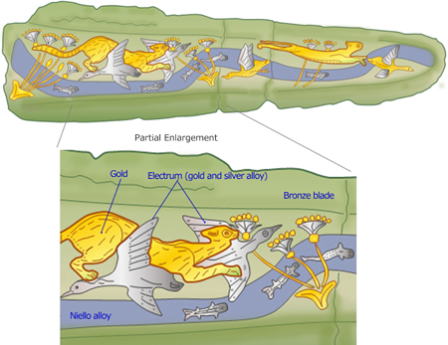 Site: Shaft Grave V, GCA, Mycenae Palace Shape & Decoration: Bronze Dagger of the “Tangles type,” with inlaid decoration of gold, niello, electrum alloy two lions (or leopards) attacking waterfowl, fish swimming in the river Era: LHI, ca. 1550 BC Museum: NAM, inv. No. 765 / L165mm Local: Argolis, Peloponnese Drawing: Eiji OKUBO VI-4-01 Pictorial style, Krater with leg 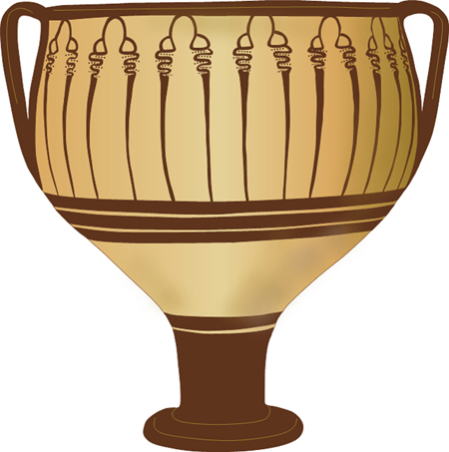 Site: Citadel, Mycenae Palace Shape & Decoration: Pictorial style, Krater with leg, whorl-shell pattern Era: LHIIIB1, 1300-1250 BC Museum: NAM, inv. No. 1148 / H370mm Local: Argolis, Peloponnese Drawing: Eiji OKUBO VI-5-05 Granary style, Stirrup Jar 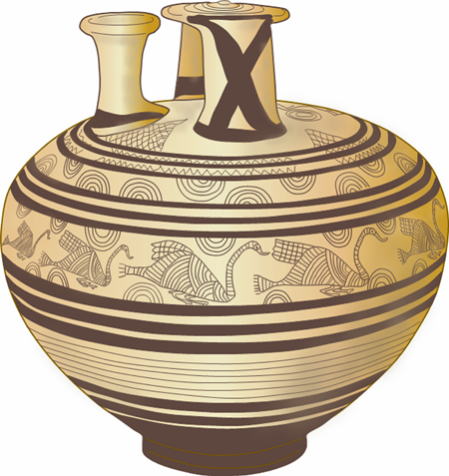 Site: Granary section, Citadel, Mycenae Palace Shape & Decoration: Granary style, Stirrup Jar with handles Close style: patterns of waterfowl, semicircles, horizontal stripes Era: LHIIIC, 1200-1150 BC Museum: NFAM, inv. No. 2844 / H220mm Local: Argolis, Peloponnese Drawing: Eiji OKUBO VIII-06 Fresco “Goat-headed Daemons” 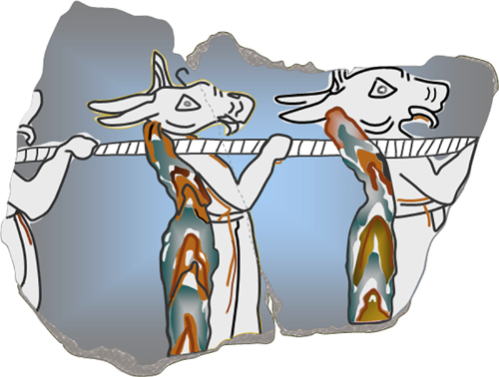 Site: House of Tsountas, Citadel, Mycenae Palace Shape & Decoration: Fresco “Goat-headed Daemons carrying palanquin poles” Era: LHIIIA2-LHIIIB1, 1375-1250 BC Museum: NAM, inv. No. 2665 / L100mm Local: Argolis, Peloponnese Drawing: Eiji OKUBO IX-01 Amethyst Seal, Fighting Soldiers 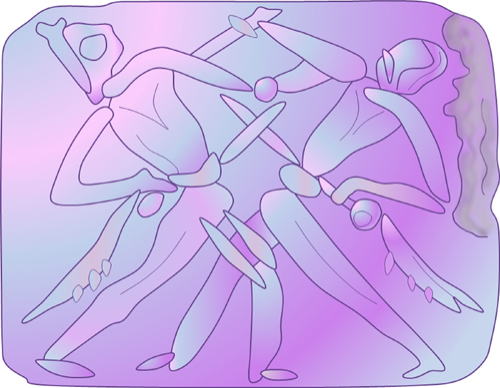 Site: Tholos Tomb, Koukounara Shape & Decoration: cushion-shaped, Amethyst Seal, soldiers fighting with swords Era: LHI-LHIIIA, 1550-1300 BC Museum: PLAM, inv. No. 13 / L17mm Local: Messenia, Peloponnese / 8km southeast from Nestor’s Palace Drawing: Eiji OKUBO GPS: 36°58'08.50''N 21°45'39''E / ALT 215m Related: Tholos Tomb, Koukounara 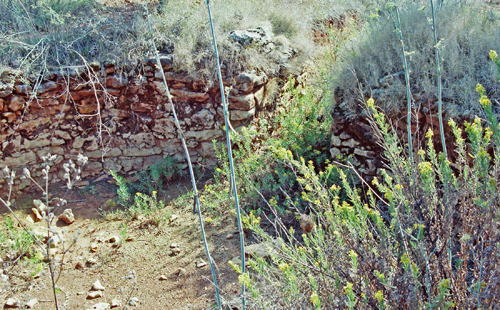 Site: Tholos Tomb 4 (temporary number), Koukounara Situation: Mycenaean Tholos tomb, view from Tholos inside to Entrance a) Tholos chamber inner diameter=7m, remaining wall height 1.2m b) Tholos burial chamber=semi-underground type c) Lintel stone unknown, Dromos/passage destroyed Era: LHI-LHIIIA, 1550-1300 BC Local: Messenia, Peloponnese / 8km southeast from Nestor’s Palace Photo: 1982 GPS: 36°58'08.50''N 21°45'39''E / ALT 215m IX-20 Agate Seal, “Bull leaping”  Site: Room of the Idols、Sanctuary, Mycenae Palace Shape & Decoration: Circular lens-shaped Agate Seal, two bulls and a leaping man Era: LHIIIB2, 1250-1200 BC Museum: NFAM, inv. No. 69-813 / L22mm (currently: MYAM, inv. No. 1861) Local: Argolis, Peloponnese Drawing: Eiji OKUBO Related: Royal Sanctuary & Shrine, Citadel, Mycenae Palace  Site: Plan of Royal Sanctuary & Shrine, Mycenae Palace a) House of the Great Ramp b) House of the Mycenaean Warrior Vase c) House of the South, Main Building and Annex d) Royal Sanctuary and Shrine e) House of Tsountas Era: Sanctuary built: LHIIIB2, ca. 1250 BC Local: Argolis, Peloponnese Drawing: Eiji OKUBO X-01 Minoan style Alabaster Vase 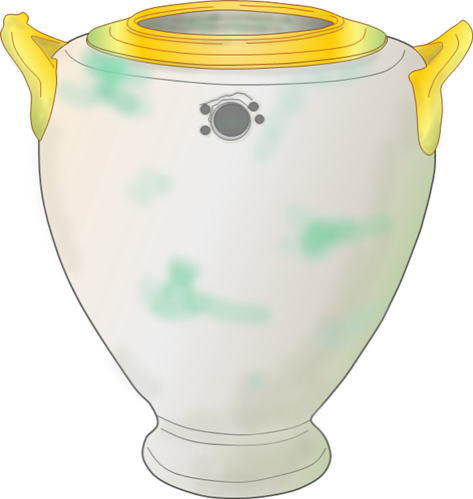 Site: Shaft Grave V, GCA, Mycenae Palace Shape & Decoration: Made in Egypt, Minoan style Alabaster vase gold coving the mouth and handles Era: LHI, ca. 1550 BC Museum: NAM, inv. No. 829 / H170mm Local: Argolis, Peloponnese Drawing: Eiji OKUBO XII-03 Ivory Statue of Female or Goddess 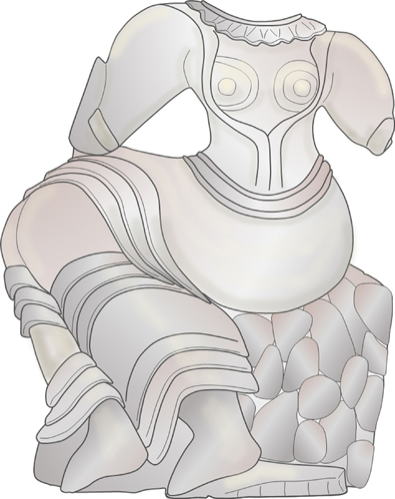 Site: Citadel, Mycenae Palace Shape & Decoration: Ivory Statue of Female or Goddess, sitting quietly on a rock Era: LHII-LHIIIA, 1500-1300 BC Museum: NAM, inv. No. 5897 / H85mm Local: Argolis, Peloponnese Drawing: Eiji OKUBO ---------- |